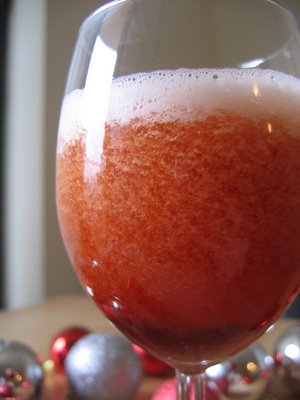 Lingon are very similar to cranberries in flavour (they are actually botanically related too), however they have rarely been cultivated and are usually found wild. They are found in climates ranging from temperate to subarctic and are therefore excellently suited to Sweden (as well as northern Canada, where another variety also grows).
Lingon are very similar to cranberries in flavour (they are actually botanically related too), however they have rarely been cultivated and are usually found wild. They are found in climates ranging from temperate to subarctic and are therefore excellently suited to Sweden (as well as northern Canada, where another variety also grows).Since I've known Jonas, lingonberries have become a familiar part of my Christmas. Like cranberries, they are also excellent accompaniments to game meat, such as reindeer steak and they are also a must-have side to Swedish meatballs.
Living in Australia, where Christmas Day can easily be +30’C (+90’F), roasts are not really a fun option and so Jonas and I devised this quick and easy little cocktail to cool off while still retaining some Swedish influence.
The tart lingonberries are perfect in this drink.
 Lingon Daiquiri
Lingon DaiquiriRecipe by Anna & Jonas. Makes 2.
Ingredients:
125ml lingonsaft (lingonberry cordial)
45ml Barcardi
45ml sugar syrup
Dash of lime juice
Method:
Blend ingredients with ice in a blender until slushy consistency. Serve immediately.
Note: you can replace any fruit syrup or cordial with the lingonsaft, but lingon cordial is usually available from Ikea worldwide.
 The lingon genus, Vaccinium, also includes blueberries, bilberries, and huckleberries. (Above botanical graphic came from Wikipedia).
The lingon genus, Vaccinium, also includes blueberries, bilberries, and huckleberries. (Above botanical graphic came from Wikipedia).Of course the word lingon is Swedish, but the berries are also known as cowberries, mountain cranberries, lowbush cranberries, European cranberries, and wild cranberries.
The berries are quite tart and so they make excellent jams, compotes, juices and syrups when cooked with sugar.
According to Wikipedia “Cowberries contain organic acids, vitamin C, provitamin A (as beta carotene), B vitamins (B1, B2, B3), and the elements potassium, calcium, magnesium, and phosphorus. In addition to these healthful nutrients, cowberries also contain phytochemicals that are thought to counteract urinary-tract infections.”
 Now if you’re wondering who this strange hairy man is, this is our family tomte. Every Swedish home has a tomte, an old man spirit who cares for you and protects you. But it's got to be two ways: he also demands respect and gifts of appreciation.
Now if you’re wondering who this strange hairy man is, this is our family tomte. Every Swedish home has a tomte, an old man spirit who cares for you and protects you. But it's got to be two ways: he also demands respect and gifts of appreciation.On Christmas Eve it is very important to leave tomten a bowl of porridge, otherwise he might get very cranky and trash your house, make your butter rancid or tie your cows’ tails together (should you have cows).
The historical importance of respecting your house’s tomte at Christmas can be seen by the fact that Swedes call Santa Claus Jultomte (which means 'Christmas tomte').
But since our tomte lives in Australia, porridge is a bit hot for him. Instead he likes to sit back with a nice lingonberry daiquiri while he watches over us.
Tack lille tomte!

Tags: morsels and musings food blog food and drink australia recipes recipe festive food fair drink cocktail daiquiri barcardi lingon lingonberry lingonsaft cowberry tomte christmas christmas recipe christmas recipes

Great presentation...now you need a green drink (Midori?) to go with it :)
ReplyDeletehow interesting in adapting your husband's customs to a local climate! The chrimaas balls create such a festive mood in your photo, also help me to visualize lingon. Your daiquiri is really beautiful, cheer!
ReplyDelete